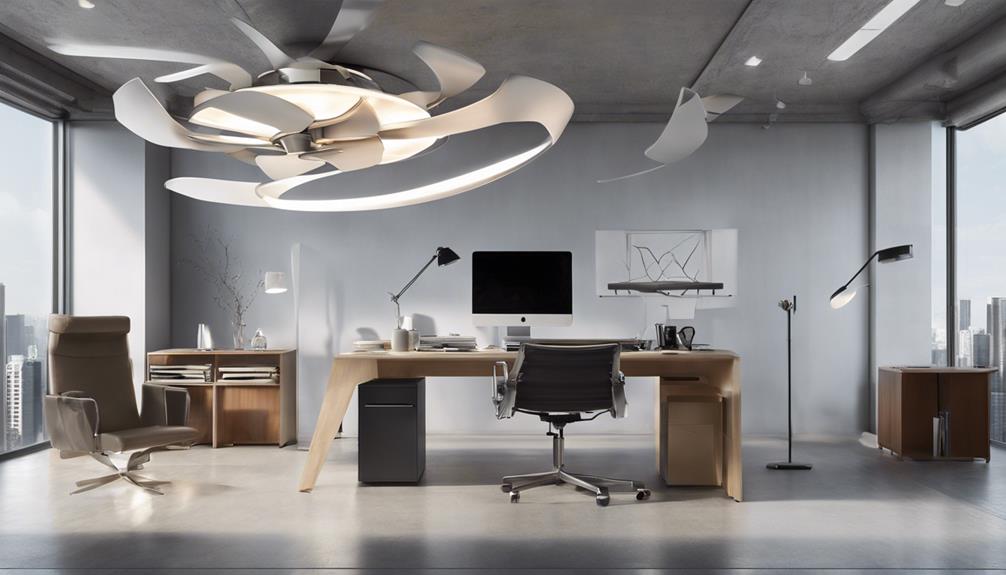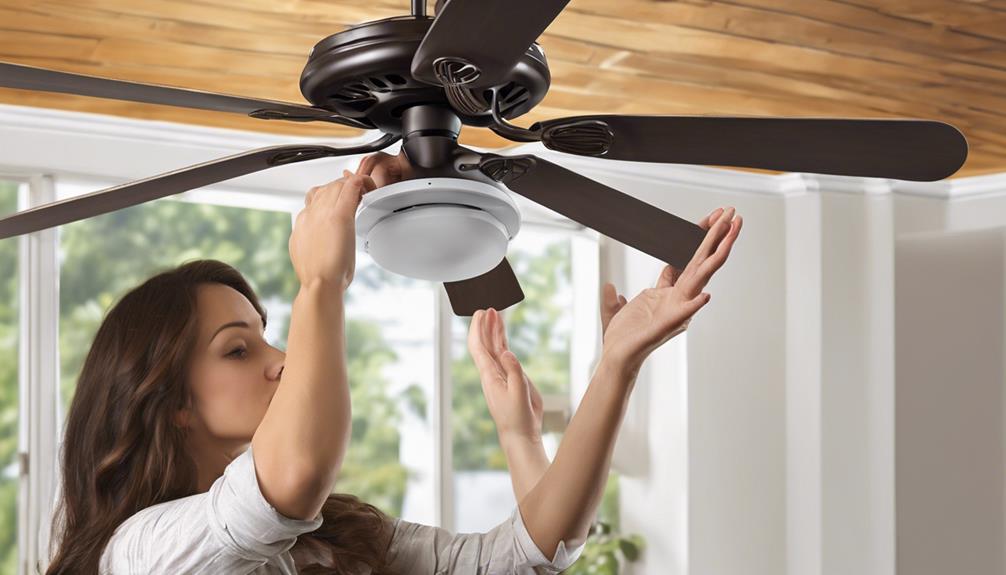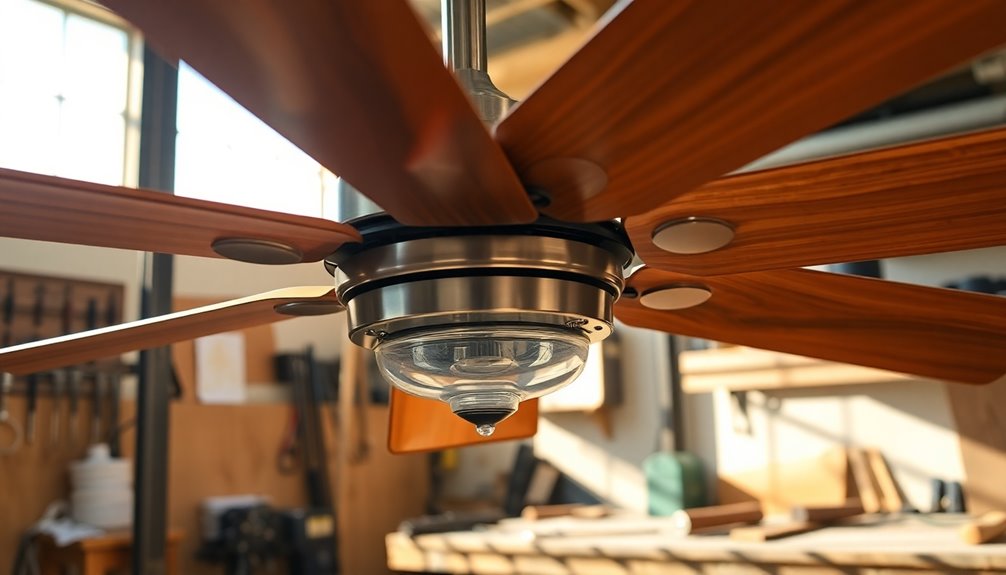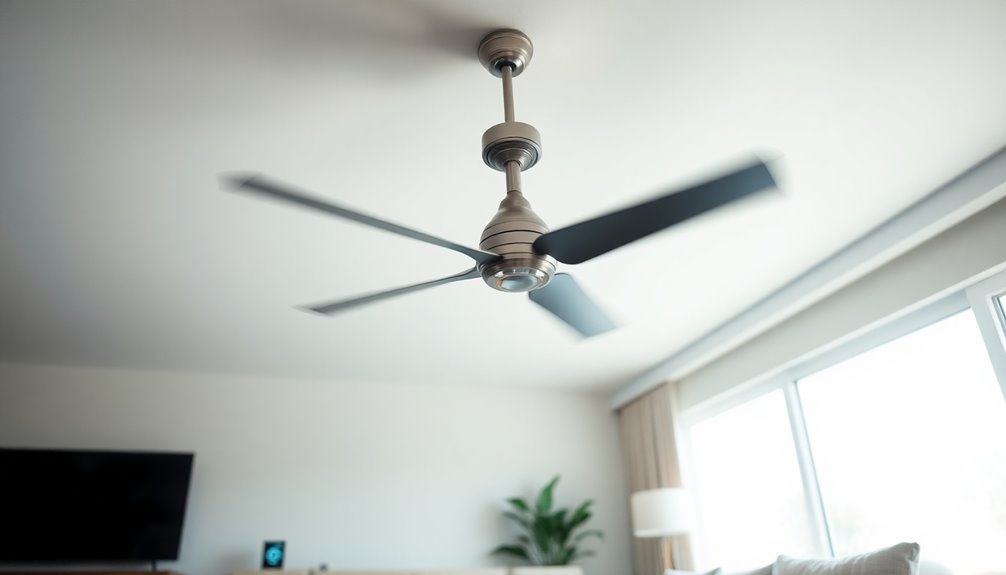Optimizing your ceiling fan placement is key for cooling your hot office efficiently. Make sure the fan is between 7 to 9 feet above the floor, with 10 to 12 inches of clearance from the ceiling and at least 18 inches away from walls. Additionally, adjusting the fan direction seasonally to counterclockwise for a cooling breeze can make a significant difference. Finally, using the fan alongside your thermostat settings can save up to 3% on cooling costs for every degree raised. These three simple steps can help improve airflow and comfort in your workspace while being cost-effective.
Key Takeaways
- Optimize fan placement for proper air circulation.
- Adjust fan direction for seasonal cooling needs.
- Use fan in conjunction with thermostat settings.
- Maintain appropriate distance from walls and ceiling.
- Install multiple fans in larger office spaces.
Optimize Ceiling Fan Placement
When positioning a ceiling fan in your office for optimal cooling, consider its placement in relation to the room's dimensions and layout. To ensure optimal air circulation, the fan should be positioned between 7 to 9 feet above the floor. Placing the fan at this height allows for efficient airflow throughout the room, keeping you cool during the workday. Additionally, maintain a distance of 10 to 12 inches between the fan blades and the ceiling to maximize airflow efficiency. It's crucial to prevent air obstruction by keeping the fan at least 18 inches away from walls.
Choosing the right ceiling fan size based on your room dimensions is essential for effective cooling. In larger office spaces, installing multiple fans can help in achieving even air distribution. By strategically placing ceiling fans in your office space, you can create a comfortable environment with consistent airflow, ensuring that you stay cool and productive throughout the day.
Adjust Fan Direction for Seasonal Cooling

Adjusting the ceiling fan direction seasonally can significantly impact the comfort and energy efficiency of your office space. During the summer months, setting your ceiling fan to spin counterclockwise creates a cooling breeze that can make you feel up to 4 degrees cooler. This is due to the wind chill effect, which helps maintain a comfortable environment without the need to lower the thermostat. Ceiling fans equipped with a remote control or a reversing switch near the motor housing make it easy to switch the fan direction for seasonal cooling.
Not only does adjusting the fan direction enhance your comfort, but it also results in energy savings. By running the fan in the correct direction, you can raise the thermostat while still enjoying a cool breeze, reducing the workload on your air conditioning system. This simple adjustment can help you stay cool and save on energy costs throughout the warmer months.
Use Ceiling Fan Alongside Thermostat Settings
Using a ceiling fan alongside thermostat settings can effectively create a cooler environment while conserving energy. By adjusting the thermostat to be slightly higher and running the ceiling fan, you can experience the wind chill effect, which helps you feel comfortable at higher temperatures.
This combination can lead to savings of up to 3% on cooling costs for every degree the thermostat is raised. Not only does this approach save on energy, but it also promotes energy efficiency in your office.
Remember to turn off the ceiling fan in unoccupied areas to maximize energy savings, as the fan primarily circulates air rather than cools it. By utilizing the ceiling fan strategically alongside thermostat adjustments, you can maintain a comfortable temperature while reducing the need for excessive air conditioning.
Embracing this method not only keeps your office cool but also contributes to a more energy-efficient workspace.
Frequently Asked Questions
Can a Ceiling Fan Cool a Hot Room?
Yes, a ceiling fan can cool a hot room by circulating air effectively, creating a wind chill effect that provides a sensation of cooling.
This energy-efficient solution optimizes temperature regulation, enhances summer comfort, and reduces heat in a room.
Properly setting the direction of the fan enhances its cooling effects, making it a valuable addition to room ventilation and overall cooling solutions.
How Do You Cool Down a Hot Office?
To cool down a hot office, I employ various strategies like using portable AC units, ice packs, window shades, desk fans, cold drinks, air circulation, dehumidifiers, ventilation systems, thermal curtains, and cooling mats.
These methods create a comfortable environment and boost productivity. Efficiently managing the temperature enhances employee well-being and fosters a positive work atmosphere.
How Do You Position a Fan in a Hot Room?
When positioning a fan in a hot room, consider placing it at a height of 7 to 9 feet for optimal air circulation. To maximize airflow efficiency, keep the fan 10 to 12 inches away from the ceiling and at least 18 inches from walls.
Choose a fan size suitable for the room dimensions, and if the room is long, consider installing multiple fans for even distribution. Proper fan placement is crucial for effective cooling strategies and maintaining thermal comfort.
How Do You Push Hot Air Out of a Room With a Fan?
To push hot air out of a room with a fan, focus on creating good air circulation. Place the fan near a window, facing outward to remove hot air effectively. Opening another window helps create a cross breeze, improving ventilation.
Using a higher fan speed aids in heat removal. Combining these techniques with ceiling fans can quickly dissipate hot air, ultimately enhancing room temperature control and air movement.
Can Ceiling Fans Help Cool Offices as Well as Other Rooms?
Ceiling fans are perfect for cooling down offices, making them one of the best rooms for fans. They help improve air circulation and keep the temperature comfortable. When used with air conditioning, ceiling fans can help distribute cool air more efficiently, reducing energy costs and making the office a more pleasant environment.
Conclusion
In conclusion, a ceiling fan can be your office's best friend in the battle against the heat.
By optimizing placement, adjusting direction, and using it alongside thermostat settings, you can create a cool and comfortable working environment.
Just like a gentle breeze on a hot summer day, a well-placed ceiling fan can provide relief and improve productivity.
So don't sweat it, let the fan do the work for you.









